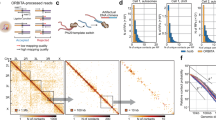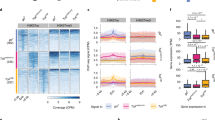Abstract
The nuclear lamina binds chromatin in vitro and is thought to function in its organization, but genes that interact with it are unknown. Using an in vivo approach, we identified ∼500 Drosophila melanogaster genes that interact with B-type lamin (Lam). These genes are transcriptionally silent and late replicating, lack active histone marks and are widely spaced. These factors collectively predict lamin binding behavior, indicating that the nuclear lamina integrates variant and invariant chromatin features. Consistently, proximity of genomic regions to the nuclear lamina is partly conserved between cell types, and induction of gene expression or active histone marks reduces Lam binding. Lam target genes cluster in the genome, and these clusters are coordinately expressed during development. This genome-wide analysis gives clear insight into the nature and dynamic behavior of the genome at the nuclear lamina, and implies that intergenic DNA functions in the global organization of chromatin in the nucleus.
This is a preview of subscription content, access via your institution
Access options
Subscribe to this journal
Receive 12 print issues and online access
$209.00 per year
only $17.42 per issue
Buy this article
- Purchase on Springer Link
- Instant access to full article PDF
Prices may be subject to local taxes which are calculated during checkout








Similar content being viewed by others
Accession codes
References
Misteli, T. Spatial positioning; a new dimension in genome function. Cell 119, 153–156 (2004).
Taddei, A., Hediger, F., Neumann, F.R. & Gasser, S.M. The function of nuclear architecture: a genetic approach. Annu. Rev. Genet. 38, 305–345 (2004).
Marshall, W.F. Order and disorder in the nucleus. Curr. Biol. 12, R185–R192 (2002).
Gartenberg, M.R., Neumann, F.R., Laroche, T., Blaszczyk, M. & Gasser, S.M. Sir-mediated repression can occur independently of chromosomal and subnuclear contexts. Cell 119, 955–967 (2004).
Andrulis, E.D., Neiman, A.M., Zappulla, D.C. & Sternglanz, R. Perinuclear localization of chromatin facilitates transcriptional silencing. Nature 394, 592–595 (1998).
Kosak, S.T. et al. Subnuclear compartmentalization of immunoglobulin loci during lymphocyte development. Science 296, 158–162 (2002).
Zink, D. et al. Transcription-dependent spatial arrangements of CFTR and adjacent genes in human cell nuclei. J. Cell Biol. 166, 815–825 (2004).
Mathog, D. & Sedat, J.W. The three-dimensional organization of polytene nuclei in male Drosophila melanogaster with compound XY or ring X chromosomes. Genetics 121, 293–311 (1989).
Hochstrasser, M. & Sedat, J.W. Three-dimensional organization of Drosophila melanogaster interphase nuclei. II. Chromosome spatial organization and gene regulation. J. Cell Biol. 104, 1471–1483 (1987).
Hochstrasser, M., Mathog, D., Gruenbaum, Y., Saumweber, H. & Sedat, J.W. Spatial organization of chromosomes in the salivary gland nuclei of Drosophila melanogaster. J. Cell Biol. 102, 112–123 (1986).
Gerasimova, T.I., Byrd, K. & Corces, V.G. A chromatin insulator determines the nuclear localization of DNA. Mol. Cell 6, 1025–1035 (2000).
Marshall, W.F., Dernburg, A.F., Harmon, B., Agard, D.A. & Sedat, J.W. Specific interactions of chromatin with the nuclear envelope: positional determination within the nucleus in Drosophila melanogaster. Mol. Biol. Cell 7, 825–842 (1996).
Taddei, A. & Gasser, S.M. Multiple pathways for telomere tethering: functional implications of subnuclear position for heterochromatin formation. Biochim. Biophys. Acta 1677, 120–128 (2004).
Casolari, J.M. et al. Genome-wide localization of the nuclear transport machinery couples transcriptional status and nuclear organization. Cell 117, 427–439 (2004).
Brickner, J.H. & Walter, P. Gene recruitment of the activated INO1 locus to the nuclear membrane. PLoS Biol. 2, e342 (2004).
Ishii, K., Arib, G., Lin, C., Van Houwe, G. & Laemmli, U.K. Chromatin boundaries in budding yeast: the nuclear pore connection. Cell 109, 551–562 (2002).
Gruenbaum, Y., Margalit, A., Goldman, R.D., Shumaker, D.K. & Wilson, K.L. The nuclear lamina comes of age. Nat. Rev. Mol. Cell Biol. 6, 21–31 (2005).
Taniura, H., Glass, C. & Gerace, L. A chromatin binding site in the tail domain of nuclear lamins that interacts with core histones. J. Cell Biol. 131, 33–44 (1995).
Luderus, M.E. et al. Binding of matrix attachment regions to lamin B1. Cell 70, 949–959 (1992).
Paddy, M.R., Belmont, A.S., Saumweber, H., Agard, D.A. & Sedat, J.W. Interphase nuclear envelope lamins form a discontinuous network that interacts with only a fraction of the chromatin in the nuclear periphery. Cell 62, 89–106 (1990).
Belmont, A.S., Zhai, Y. & Thilenius, A. Lamin B distribution and association with peripheral chromatin revealed by optical sectioning and electron microscopy tomography. J. Cell Biol. 123, 1671–1685 (1993).
Marshall, W.F., Fung, J.C. & Sedat, J.W. Deconstructing the nucleus: global architecture from local interactions. Curr. Opin. Genet. Dev. 7, 259–263 (1997).
Kosak, S.T. & Groudine, M. Gene order and dynamic domains. Science 306, 644–647 (2004).
van Steensel, B., Delrow, J. & Henikoff, S. Chromatin profiling using targeted DNA adenine methyltransferase. Nat. Genet. 27, 304–308 (2001).
van Steensel, B. & Henikoff, S. Identification of in vivo DNA targets of chromatin proteins using tethered dam methyltransferase. Nat. Biotechnol. 18, 424–428 (2000).
Bianchi-Frias, D. et al. Hairy transcriptional repression targets and cofactor recruitment in Drosophila. PLoS Biol. 2, E178 (2004).
Greil, F. et al. Distinct HP1 and Su(var)3–9 complexes bind to sets of developmentally coexpressed genes depending on chromosomal location. Genes Dev. 17, 2825–2838 (2003).
van Steensel, B., Delrow, J. & Bussemaker, H.J. Genomewide analysis of Drosophila GAGA factor target genes reveals context-dependent DNA binding. Proc. Natl. Acad. Sci. USA 100, 2580–2585 (2003).
Sun, L.V. et al. Protein-DNA interaction mapping using genomic tiling path microarrays in Drosophila. Proc. Natl. Acad. Sci. USA 100, 9428–9433 (2003).
Kitten, G.T. & Nigg, E.A. The CaaX motif is required for isoprenylation, carboxyl methylation, and nuclear membrane association of lamin B2. J. Cell Biol. 113, 13–23 (1991).
Schübeler, D. et al. The histone modification pattern of active genes revealed through genome-wide chromatin analysis of a higher eukaryote. Genes Dev. 18, 1263–1271 (2004).
Elgin, S.C. Heterochromatin and gene regulation in Drosophila. Curr. Opin. Genet. Dev. 6, 193–202 (1996).
O'Keefe, R.T., Henderson, S.C. & Spector, D.L. Dynamic organization of DNA replication in mammalian cell nuclei: spatially and temporally defined replication of chromosome-specific alpha-satellite DNA sequences. J. Cell Biol. 116, 1095–1110 (1992).
Schübeler, D. et al. Genome-wide DNA replication profile for Drosophila melanogaster: a link between transcription and replication timing. Nat. Genet. 32, 438–442 (2002).
MacAlpine, D.M., Rodriguez, H.K. & Bell, S.P. Coordination of replication and transcription along a Drosophila chromosome. Genes Dev. 18, 3094–3105 (2004).
Stolc, V. et al. A gene expression map for the euchromatic genome of Drosophila melanogaster. Science 306, 655–660 (2004).
Boutanaev, A.M., Kalmykova, A.I., Shevelyov, Y.Y. & Nurminsky, D.I. Large clusters of co-expressed genes in the Drosophila genome. Nature 420, 666–669 (2002).
Spellman, P.T. & Rubin, G.M. Evidence for large domains of similarly expressed genes in the Drosophila genome. J. Biol. 1, 5 (2002).
Echalier, G. in Drosophila Cells in Culture 393–438 (Academic, New York, 1997).
Marshall, W.F. et al. Interphase chromosomes undergo constrained diffusional motion in living cells. Curr. Biol. 7, 930–939 (1997).
Heun, P., Laroche, T., Raghuraman, M.K. & Gasser, S.M. The positioning and dynamics of origins of replication in the budding yeast nucleus. J. Cell Biol. 152, 385–400 (2001).
Vazquez, J., Belmont, A.S. & Sedat, J.W. Multiple regimes of constrained chromosome motion are regulated in the interphase Drosophila nucleus. Curr. Biol. 11, 1227–1239 (2001).
Walter, J., Schermelleh, L., Cremer, M., Tashiro, S. & Cremer, T. Chromosome order in HeLa cells changes during mitosis and early G1, but is stably maintained during subsequent interphase stages. J. Cell Biol. 160, 685–697 (2003).
Makatsori, D. et al. The inner nuclear membrane protein lamin B receptor forms distinct microdomains and links epigenetically marked chromatin to the nuclear envelope. J. Biol. Chem. 279, 25567–25573 (2004).
Somech, R. et al. The nuclear-envelope protein and transcriptional repressor LAP2beta interacts with HDAC3 at the nuclear periphery, and induces histone H4 deacetylation. J. Cell Sci. 118, 4017–4025 (2005).
Croft, J.A. et al. Differences in the localization and morphology of chromosomes in the human nucleus. J. Cell Biol. 145, 1119–1131 (1999).
Cremer, M. et al. Inheritance of gene density-related higher order chromatin arrangements in normal and tumor cell nuclei. J. Cell Biol. 162, 809–820 (2003).
Taddei, A., Roche, D., Bickmore, W.A. & Almouzni, G. The effects of histone deacetylase inhibitors on heterochromatin: implications for anticancer therapy? EMBO Rep 6, 520–524 (2005).
Stuurman, N., Maus, N. & Fisher, P.A. Interphase phosphorylation of the Drosophila nuclear lamin: site-mapping using a monoclonal antibody. J. Cell Sci. 108, 3137–3144 (1995).
Smyth, G.K. Linear models and empirical Bayes methods for assessing differential expression in microarray experiments. Stat. Appl. Genet. Mol. Biol. 3, Article3 (2004).
Acknowledgements
We thank J. Delrow and M. Aronszajn (Genomics facility, Fred Hutchinson Cancer Research Center) for providing and annotating of cDNA arrays; N. Stuurman for plasmids, antibodies and helpful suggestions; F. Greil and C. Moorman for valuable technical advice; G. Hart for advice on statistical methods; M. Heimerikx and the NKI microarray facility for technical support; L. Guelen, H. van der Velde, J. Hendriksen and D. Engelsma for scoring of the FISH images; and J.M. Boer, S. Nijman, F. van Leeuwen, J. Neefjes, M. van Lohuizen and members of the van Steensel and Fornerod labs for helpful discussions and critical reading of the manuscript. This work was supported by a Marie Curie European Community Training and Mobility grant to H.P. and an European Young Investigator Award to B.v.S.
Author information
Authors and Affiliations
Contributions
H.P., M.F. and B.v.S. conceived and designed the project; H.P. performed DamID, expression profiling and microscopy experiments and designed FISH probes; B.K. developed and performed FISH experiments; W.T. performed ChIP; E.d.W., M.F. and B.v.S. designed and performed computational analyses and H.P., M.F. and B.v.S. wrote the manuscript with help from B.K. and E.d.W.
Corresponding authors
Ethics declarations
Competing interests
The authors declare no competing financial interests.
Supplementary information
Supplementary Fig. 1
Estimate of DNA content in the nuclear periphery. (PDF 273 kb)
Supplementary Fig. 2
Genomic Lamin binding in embryonic cells shows significant correspondence to polytene chromosome nuclear envelope contacts in larvae. (PDF 116 kb)
Supplementary Fig. 3
Genes bound by Lam are repressed, lack active histone marks and are late replicating. (PDF 157 kb)
Supplementary Fig. 4
The binding pattern of Lam is distinct from that of HP1 and Su(var)3-9. (PDF 1100 kb)
Supplementary Fig. 5
Developmental expression profiles of Lam target gene clusters. (PDF 99 kb)
Supplementary Table 1
Excel spreadsheet containing DamID data, clustering data, expression profiling, flanking intergenic region lengths, probe annotation and gene ontology analysis of Lam-binding genes. (XLS 6469 kb)
Supplementary Table 2
Characteristics of FISH probes. (PDF 86 kb)
Supplementary Table 3
Multiple regression analysis of Lam binding. (PDF 64 kb)
Rights and permissions
About this article
Cite this article
Pickersgill, H., Kalverda, B., de Wit, E. et al. Characterization of the Drosophila melanogaster genome at the nuclear lamina. Nat Genet 38, 1005–1014 (2006). https://doi.org/10.1038/ng1852
Received:
Accepted:
Published:
Issue Date:
DOI: https://doi.org/10.1038/ng1852
This article is cited by
-
Strong interactions between highly dynamic lamina-associated domains and the nuclear envelope stabilize the 3D architecture of Drosophila interphase chromatin
Epigenetics & Chromatin (2023)
-
Photoselective sequencing: microscopically guided genomic measurements with subcellular resolution
Nature Methods (2023)
-
Deformation of the nucleus by TGFβ1 via the remodeling of nuclear envelope and histone isoforms
Epigenetics & Chromatin (2022)
-
Genomic loci mispositioning in Tmem120a knockout mice yields latent lipodystrophy
Nature Communications (2022)
-
Establishment of H3K9-methylated heterochromatin and its functions in tissue differentiation and maintenance
Nature Reviews Molecular Cell Biology (2022)



